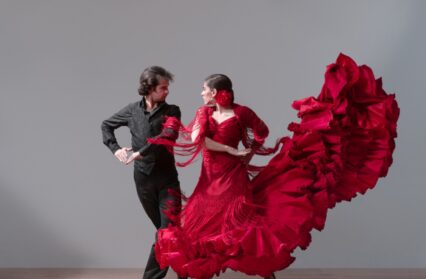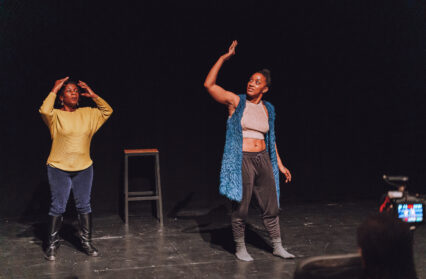In a new Big Read feature, award-winning poet Paul Chambers delves into the world of flamenco art and explores the poetic concentration and lyricism which underpins this distinctive musical form.
The cante, the song, is the soul of flamenco art. Before the later additions of toque (guitar), and baile (dance), the cante jondo, or deep song, of flamenco, gave form to what flamencologist Ricardo Molina describes as “the cry of a man mortally wounded by destiny.” While most often bearing a fatalistic tinge, the lyrics of flamenco song represent a complete vision of life, conveyed with an intense poetic concentration.
To isolate the lyrics of flamenco song from the intensely impassioned stylisations of its performers is undoubtedly to diffuse them of a vast amount of their emotional power. And yet, in many cases, their poetry retains a profound resonance. For Federico Garcia Lorca, the primitive lyric of the gypsy cante jondo is a “channel through which all the pain, all the ritual gestures of the race, can escape.”
Cuando yo me muera,
te pío un encargo,
que con las trenzas tu pelo negro
me marren las manos.
When I come to die,
I ask of you one favour,
that with the tresses of your black hair
they bind my hands.
(See the accompanying playlist below to hear ‘Cuando yo me muera’ in full)
A theory put forward as to the origin of the word ‘flamenco’ is that it’s an amalgamation of the Arabic words ‘felag’ and ‘mengu’, which translates as ‘fugitive peasant’. The label goes some way in explaining the impoverished agonies and fatalism of many of the lyrics of the cante jondo. It is the song of persecuted peoples – an expression of the suffering of centuries. Following the Catholic conquest of Spain in 1492, successive rulers sought to impose strict restrictions on nomadic gypsy communities, forcing them to settle in one location and engage in ‘respectable’ employment. Individuals who failed to comply with these restrictions risked severe punishment. Small gypsy districts began to spring up in towns and cities across Andalucia, into which were also absorbed Jewish and Moorish populations seeking refuge from religious persecution at the hands of the Christians. And it was out of the cultural and artistic melting pot of the barrios that flamenco was born.
From cradle to grave, the poetry of flamenco condenses the most emotional moments of life into spiritual drama. This isn’t to say, however, that the catalogue is made up entirely of expressions of pain. There are categories of flamenco song, such as cante chico, or light song, which are sunnier and less demanding than the black moods of the cante jondo.
Eres chiquita y bonita,
eres como te quiero,
eres una campanita
en las manos de un platero.
You are little and pretty,
you are just as I want you,
you are a tiny bell
in the hands of a silversmith.
In a similar manner are the nanas – a form of song whose lyrics express tender and intimate affection for children. They are cradle songs, sung to babies to lull them to sleep.
Clavelito encarnado,
rosa en capullo,
duérmete, vida mía,
mientras te arruyo.
Little pink carnation,
rose yet to bud,
sleep now, my life,
while I rock you.
Nana, nana… ay… nana,
duermete, lucerito de la
manana…
Slumber song… ay… slumber song,
sleep, little star of the
morning…
The close-knit family bonds and strong matriarchal presence in gypsy households is reflected in a large number of flamenco songs in which the figure of the mother plays a central role. There is often an element of loss and sorrow evoked in verses concerning mothers. Undoubtedly much of the content and tone of these songs are coloured by the devotion for the Virgin Mary.
Por una ventana
que al campo salía,
yo daba voces a la mare de mi alma
y no me respondía
Through a window
which was facing the fields,
I was calling to the mother of my soul
and she did not answer me.
Penas tiene mi mare,
penas tengo yo,
y las que siento son las de mi mare,
que las mas no.
My mother has her sorrows,
I have mine,
and the ones I feel are my mother’s,
not my own.
The themes of love, longing, and relationships are explored in intense complexity throughout flamenco song. In certain cases, romantic sentiments are expressed through lighter, optimistic songs of flattery.
De rosas y claveles
y de alhelíes
se te llena la boca
cuando te ríes.
Your mouth fills
with roses and carnations
and jasmine
when you laugh.
Es tu pecho redoma
Llena de olores,
Donde se purifican
Todas las flores.
The flowers
are scented
by the perfume
of your breasts.
In the majority of songs on the theme of love, however, the singer expresses an irreconcilable doom for an affair that has ended, or a deep yearning that remains unfulfilled.
Todas las mañanas voy
a preguntarle al romero
si el mal de amor tiene cura
porque yo me estoy muriendo.
Every morning I go
to ask the rosemary
if love’s ill can be cured,
for I am dying.
Yo me enamore del aire,
del aire de una mujer.
Como la mujer es aire,
en el aire me quedé.
I fell in love with the air,
the air of a woman.
Since a woman is air,
in the air I remain.
Perhaps the subject explored most broadly in the flamenco catalogue is the suffering of impoverished and persecuted individuals. These songs are often very specific to the conditions and locations in which the singer’s suffering is rooted. For instance, the carceleras are songs that are sung in prisons.
Veinticinco calabozos
tiene la cárcel de Utrera.
Veinticuatro he recorrido
y el más oscuro me queda.
The prison in Utrera
has twenty-five cells.
I have been in twenty-four
and the darkest is to come.
In some cases, the suffering and resignation finds its parallel in a form of physical labour, such as farming, mining, or black-smithery. A form of cante jondo, the martinete, comprises a lone singer and the rhythmic accompaniment of the hammering of an anvil.
jAy!, que me he quedao
manquito y cojo,
que de cortar
las catias de canta
en los cataverales…
Ayyy, como darle de comer
A mi pare, a mi mare…
Ay! I have been left
maimed and crippled
from cutting
cane after cane
in the cane fields…
Ayyy, how to feed
my father and my mother…
No se espante usted, señora,
que es un minero quien canta;
con el jumo de las minas
tiene ronca la garganta.
Don’t be frightened, señora,
it’s just a miner singing;
with the smoke of the mines
his voice has turned hoarse.
In other instances, the suffering being expressed by the singer has no named cause. The lyric becomes an articulation of a curse against fate. Several of these early flamenco forms are performed without musical accompaniment, their bareness heightening the intensity of the listener experience. In Laurie Lee’s A Rose for Winter, a performance of deep song is described as “an animal cry, thrown out over burning rocks, a call half-lost in air but imperative and terrible.” The singing of the cante jondo does not serve to please its listeners, it serves to wound them.
Quisiera por ocasiones
estar loco y no sentir,
que el ser loco quita penas,
penas que no tienen fin.
Sometimes I would like
to be mad and not feel,
for being mad takes away sorrow,
sorrow that has no end.
Yo soy como el árbol solo
que está en medio del camino,
no tengo calor de naide;
¡maldito sea mi sino,
que a sufrir no hay quien me iguale!
I am like a solitary tree,
halfway along the road,
I have no warmth from anyone;
a curse on my fate,
for in suffering I have no equal!
Often the weight of suffering leads cante jondo singers to confront the subject of their own mortality; their songs haunted by an embodied conflict with death. Mention here must be made of a flamenco singer’s search for the mythical duende – an elemental, demonic earth spirit, embodying darkness and awareness of death. Much over-romanticism and misappropriation has been inflicted on the notion of duende. But for flamencologist, Donn Pohren, duende represents “the exposure of one’s soul, its misery and suffering, love and hate…It is a cry of despair, a release of tortured emotions.” The spirit of duende is one that a singer seeks to invoke in flamenco performance.
Con las fatiguitas de la muerte
a un laíto yo me arrimé;
con los deitos de la mano
arañaba la pared.
With the weariness of death
I drew to one side;
with the fingers of my hand
I clawed at the wall.
Una noche e trueno
yo pensé morí,
como tenía una sombra negra
ensima de mí.
One stormy night
I thought I would die,
because a black shadow
hung over me.
If there does come a sense of relief from life’s emotional agonies, it often takes the form of a spiritual redemption mirrored in the suffering of Christ. The religious songs of flamenco, often sung during holy processions, are the saetas – symbolic embodiments of so many of the literal themes of flamenco song.
Míralo por onde viene
agobiao por el doló,
chorreando por las sienes
gotas de sangre y suor.
Y su mare de penita
destrosao er corazón.
Look at him come
bent with pain,
his brow dripping
with blood and sweat.
And his suffering mother
with her heart broken.
Even in its darkest moments, an unquenchable spirit runs through flamenco song. Though many of its songs are expressions of life’s most profound sorrows and persecutions, they are, in and of themselves, moments of defiance. And in the lighter forms of flamenco, an infectious gaiety and passion reflects the spirited resilience of gypsy communities. These songs are testament to a living art.
Lo gitano
va en la masa de la sangre
y en las rayas de las manos.
That which is gypsy
runs in the surge of the blood
and in the grooves of the hands.
Certainly, an element of the emotive power of flamenco is diluted in the reproduction of its lyrics. It is, after all, an art of performance. It flourishes through impulse. And yet something of the colour of the art permeates the literary quality of so many of these songs. In the words of Garcia Lorca, they embody a “true, living style, of blood, of the most ancient culture, of spontaneous creation…the blush of all that is truly alive”.
Paul Chambers is an award-winning haikuist, and has written for the TLS on the haiku of Lorca. You can listen to Paul’s Flamenco playlist above, or via the WAR Spotify page.




